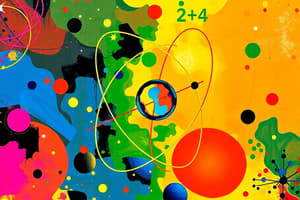Podcast
Questions and Answers
What is the range of integral values for the magnetic quantum number (ml)?
What is the range of integral values for the magnetic quantum number (ml)?
- From 0 to -l, excluding -l
- From -l to 0, excluding zero
- From -l to l, including zero (correct)
- From 0 to l
How many orbitals are present in the p subshell?
How many orbitals are present in the p subshell?
- 2 orbitals
- 4 orbitals
- 1 orbital
- 3 orbitals (correct)
What is the value of the electron spin quantum number (ms) for an electron spinning in one direction?
What is the value of the electron spin quantum number (ms) for an electron spinning in one direction?
- 1
- -1/2
- 1/2 (correct)
- 0
How many integral values does the magnetic quantum number (ml) take for l=2?
How many integral values does the magnetic quantum number (ml) take for l=2?
What distinguishes the three p orbitals from each other?
What distinguishes the three p orbitals from each other?
Which of the following accurately represents the number of orbitals in an f subshell?
Which of the following accurately represents the number of orbitals in an f subshell?
What is the total number of orbitals available when l=1?
What is the total number of orbitals available when l=1?
What defines the energy and shape differences among various types of subshells?
What defines the energy and shape differences among various types of subshells?
What does the principal quantum number (n) determine about an orbital?
What does the principal quantum number (n) determine about an orbital?
How is the angular momentum quantum number (l) related to the principal quantum number (n)?
How is the angular momentum quantum number (l) related to the principal quantum number (n)?
What is the maximum value of the angular momentum quantum number (l) for n=4?
What is the maximum value of the angular momentum quantum number (l) for n=4?
Which quantum number specifies the magnetic property of an electron's spin?
Which quantum number specifies the magnetic property of an electron's spin?
What does the energy of an orbital primarily depend on?
What does the energy of an orbital primarily depend on?
What term describes the three-dimensional region where an electron is most likely to be found?
What term describes the three-dimensional region where an electron is most likely to be found?
If an electron is in a 5d orbital, what is the value of n and l?
If an electron is in a 5d orbital, what is the value of n and l?
In which scenario does the energy of an orbital increase for a given principal quantum number n?
In which scenario does the energy of an orbital increase for a given principal quantum number n?
Flashcards
Principal Quantum Number (n)
Principal Quantum Number (n)
A quantum number representing the energy level of an electron in an atom.
Angular Momentum Quantum Number (l)
Angular Momentum Quantum Number (l)
A quantum number describing the shape of an electron's orbital.
Magnetic Quantum Number (ml)
Magnetic Quantum Number (ml)
A quantum number describing the orientation of an electron's orbital in space.
Spin Quantum Number (ms)
Spin Quantum Number (ms)
Signup and view all the flashcards
Atomic Orbital
Atomic Orbital
Signup and view all the flashcards
Quantum Numbers
Quantum Numbers
Signup and view all the flashcards
Energy Dependence on Quantum Numbers n and l
Energy Dependence on Quantum Numbers n and l
Signup and view all the flashcards
Subshell Notation
Subshell Notation
Signup and view all the flashcards
What is the magnetic quantum number (ml)?
What is the magnetic quantum number (ml)?
Signup and view all the flashcards
How do you determine the possible values of ml?
How do you determine the possible values of ml?
Signup and view all the flashcards
What does each value of ml represent?
What does each value of ml represent?
Signup and view all the flashcards
How many orbitals are in a subshell?
How many orbitals are in a subshell?
Signup and view all the flashcards
What is the electron spin quantum number (ms)?
What is the electron spin quantum number (ms)?
Signup and view all the flashcards
What are the possible values for ms?
What are the possible values for ms?
Signup and view all the flashcards
How many orbitals are in each subshell?
How many orbitals are in each subshell?
Signup and view all the flashcards
Why are atomic orbitals important?
Why are atomic orbitals important?
Signup and view all the flashcards
Study Notes
Quantum Theory of the Atom
- Each electron in an atom is described by four quantum numbers.
- Three of these quantum numbers (n, l, and ml) describe the electron's wave function, determining the probability of finding the electron in various locations.
- The fourth quantum number (ms) describes the electron's spin.
Quantum Numbers
- Principal Quantum Number (n):
- Integral values (1, 2, 3...).
- Higher n values indicate higher energy levels.
- Higher n values also correspond to orbitals further from the nucleus.
- Angular Momentum Quantum Number (l):
- Integral values from 0 to n-1.
- Related to the shape of atomic orbitals.
- Values of l are often represented by letters: 0=s, 1=p, 2=d, 3=f, 4=g.
- Magnetic Quantum Number (ml):
- Integral values between -l and +l, including zero.
- Indicates the orientation of the orbital in space.
- For a given l, there are 2l+1 possible ml values.
- Electron Spin Quantum Number (ms):
- Can be +1/2 or -1/2.
- Represents the intrinsic angular momentum (spin) of the electron.
Atomic Orbitals
- A wave function for an electron in an atom is called an atomic orbital.
- Each subshells contains one or more orbitals - s = 1 orbital, p = 3 orbitals, d = 5 orbitals, f= 7 orbitals
- Each orbital type has a different shape and energy.
- An orbital can hold 2 electrons.
Examples of quantum numbers
- 2p has n=2, l=1.
- 3d has n=3, l=2.
- 4f has n=4, l=3.
Orbital Shapes
- Examples of s, p & d orbitals shapes are presented.
- Note that p orbitals have different spatial orientations, while d orbitals have a broader range of shapes.
Studying That Suits You
Use AI to generate personalized quizzes and flashcards to suit your learning preferences.




